Proper timing of your SAD treatment directly impacts its effectiveness by aligning with your body's natural circadian rhythm. When you time light therapy correctly – typically between 6:00 a.m. and 9:00 a.m. – you'll see up to 80% higher success rates compared to evening sessions. Your body responds best to morning light exposure because it helps regulate essential neurotransmitters like serotonin and melatonin, which control mood and sleep patterns. Starting treatment in early autumn, before symptoms appear, and maintaining consistent daily sessions can make the difference between significant relief and treatment failure. The science behind these timing principles reveals fascinating insights about your body's internal clock.
The Science Behind SAD
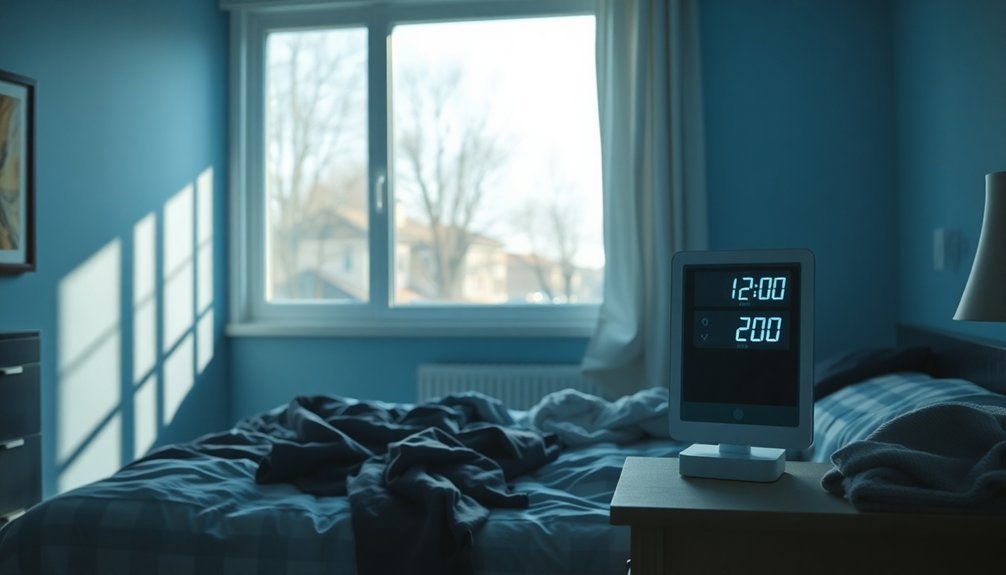
Depression's seasonal rhythm finds its roots in complex biological mechanisms. When you're experiencing Seasonal Affective Disorder (SAD), several biological processes are working together to influence your mood.
Your brain's suprachiasmatic nucleus acts as an internal clock, using light exposure to regulate your circadian rhythms and melatonin production. SAD appears more frequently in locations far from the equator, where daylight hours become significantly shorter during winter months.
At around 8:00 PM, your body naturally begins producing melatonin under dim light conditions. However, reduced sunlight exposure can disrupt this process, affecting both your sleep patterns and serotonin levels.
You'll likely notice changes in your neurotransmitter function, particularly serotonin, which often leads to increased carbohydrate cravings as your body attempts to compensate for lower serotonin levels.
Your genes also play a vital role. If you carry specific genetic variations, like the PER3 gene mutation, you're more susceptible to unusual sleep patterns and seasonal depression.
Research using animal models has revealed that these genetic factors interact with seasonal changes to influence mood and behavior. The combination of disrupted circadian rhythms, altered neurotransmitter function, and genetic predisposition creates the complex pathophysiology that characterizes SAD.
Light Therapy Timing Matters
Understanding your body's internal clock is central to effective light therapy treatment. When you sync light exposure with your biological rhythms, you'll double your chances of successful treatment, with remission rates jumping from 35% to 80%. For the best results, you'll want to start your light therapy sessions immediately after waking, typically between 6:00 a.m. and 9:00 a.m. Young women who live in northern latitudes are particularly susceptible to SAD.
| Timing Factor | Recommendation | Impact |
|---|---|---|
| Daily Duration | 30 minutes | Maintains consistent circadian rhythm |
| Distance | 12-18 inches | Guarantees ideal light exposure |
| Time of Day | Early morning | Maximizes therapeutic benefits |
While both morning and evening sessions can improve SAD symptoms, morning light therapy typically works best as it helps push your internal clock forward. You'll need to maintain a consistent schedule and use a 10,000 lux light box for best results. Remember, proper timing doesn't just mean picking the right hour – it's about finding your personal sweet spot based on your sleep patterns and melatonin onset. If you experience any discomfort like headaches or anxiety, adjust your exposure time or distance from the light source.
Melatonin's Role in Treatment
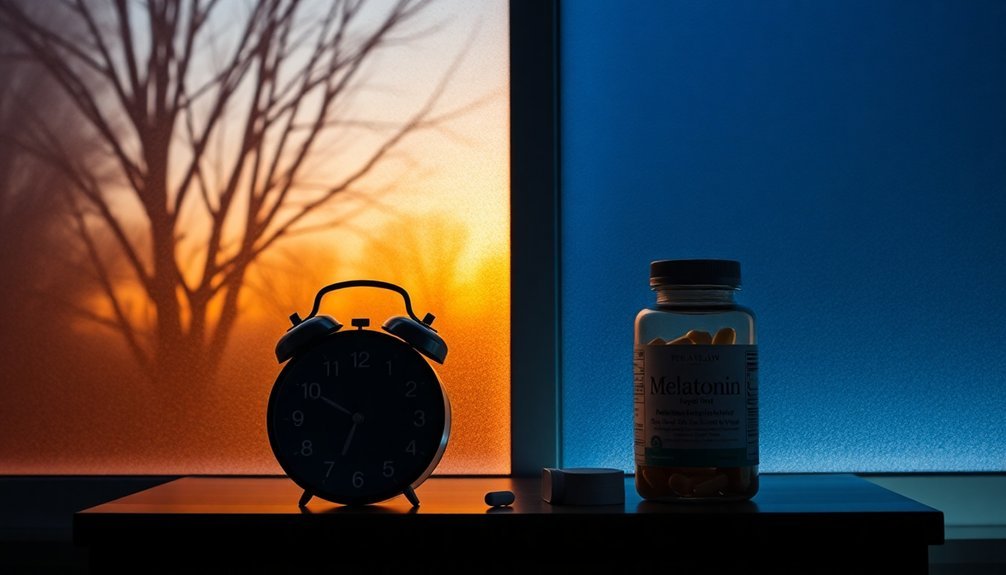
The body's natural sleep hormone, melatonin, plays a complex role in SAD treatment, but it's not a standalone solution. While you shouldn't rely on it as your primary treatment, melatonin can help adjust your circadian rhythms when timed correctly. Recent research conducted by OHSU researchers in Oregon has shown promising results over a four-year study period.
If you're considering melatonin for SAD, timing is essential. Taking it in the afternoon can help if you're phase-delayed (a night owl), while morning doses might worsen your symptoms.
You'll want to stick to low doses to avoid drowsiness, and remember that evening administration might improve your sleep but won't substantially impact your SAD symptoms.
Your circadian rhythm misalignment type matters importantly. If you're phase-delayed, you'll benefit from afternoon or evening melatonin, but if you're phase-advanced (a morning lark), different timing might be necessary. Think of it like jet lag – your internal clock needs the right adjustment at the right time.
For the best results, you'll want to combine melatonin with other treatments. Light therapy remains the gold standard for SAD treatment, and adding vitamin D supplements or antidepressants might provide additional benefits.
Always consult your healthcare provider to determine the most effective timing and combination for your specific situation.
Morning Vs Evening Sessions
While melatonin can support SAD treatment, the timing of light therapy sessions stands out as a primary factor in treatment success. Less natural sunlight during fall and winter months makes consistent timing even more crucial.
Your morning light therapy sessions offer markedly better antidepressant effects by advancing your circadian phase, especially when you time them near your wake-up time.
You'll get the best results when you schedule your light therapy about 8.5 hours after your melatonin onset, typically 2.5 to 3.5 hours after your sleep cycle's midpoint. This timing helps push your body clock forward, effectively relieving depression symptoms.
While evening sessions can help – showing a 70% response rate in some studies – they're not your best choice. Evening light delays your circadian phase and doesn't provide the same antidepressant benefits as morning sessions. That's why healthcare providers typically don't recommend evening sessions as your first treatment option.
Your individual circadian rhythm matters considerably. The effectiveness of your treatment depends heavily on how well you sync the timing with your personal melatonin onset.
If you're starting light therapy, work with your healthcare provider to determine the best timing based on your specific sleep-wake patterns.
Understanding Your Circadian Rhythm
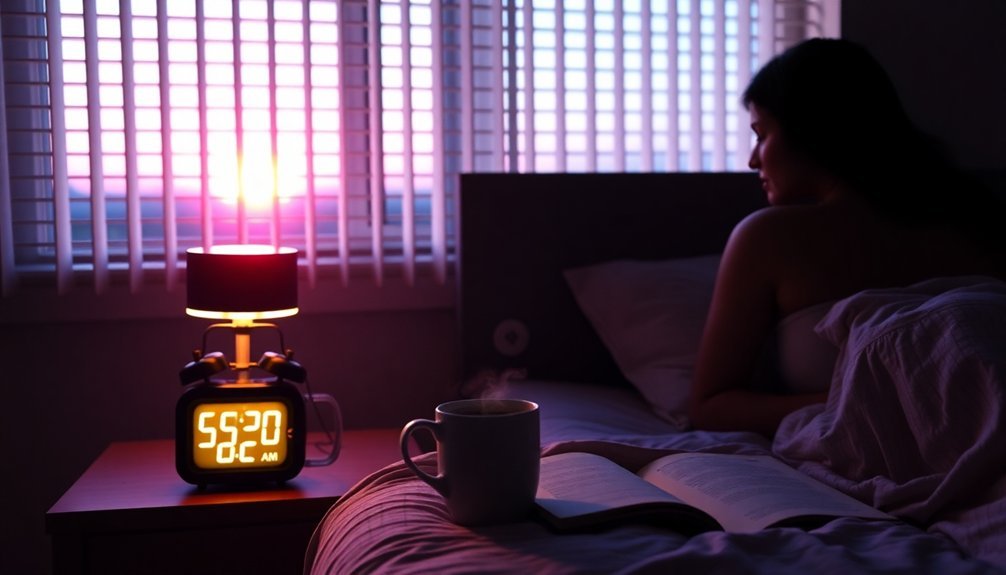
Inside your body, a natural 24-hour clock governs your sleep patterns, hormone production, and overall well-being. This internal timekeeper, known as your circadian rhythm, helps you adapt to environmental changes and maintains essential biological processes throughout the day.
Your body responds to external cues called zeitgebers that regulate this internal clock. While light remains the most powerful zeitgeber, other factors like meal timing, exercise, and social interactions can influence your circadian rhythm.
| Time of Day | Biological Process | Impact on SAD |
|---|---|---|
| Morning | Temperature Rise | Critical for Reset |
| Midday | Peak Alertness | Ideal Light Exposure |
| Afternoon | Body Temperature Peak | Maintenance Phase |
| Evening | Melatonin Release | Light Sensitivity |
| Night | Deep Sleep | Recovery Period |
When your circadian rhythm becomes misaligned, you're more susceptible to SAD symptoms. This explains why changes in daylight hours during winter months can trigger mood changes and depression. You'll benefit most from maintaining consistent daily routines, especially regarding sleep schedules. If you're experiencing SAD symptoms, understanding and working with your natural rhythm, rather than against it, becomes essential for effective treatment timing.
Optimal Treatment Windows
Your most effective treatment window for SAD occurs about 8.5 hours after your natural melatonin onset, typically making early morning light therapy the best choice.
While you'll need to maintain consistency with your chosen treatment time, your individual response may vary based on your unique circadian rhythm and lifestyle patterns.
Starting treatment before winter symptoms emerge and continuing through early spring will give you the best chance of managing SAD effectively throughout the season.
Peak Morning Light Benefits
Understanding when to schedule light therapy can substantially impact its effectiveness in treating SAD. Research consistently shows that morning light exposure produces superior results compared to evening sessions, with morning therapy achieving 50% remission rates versus 40% for evening treatment.
You'll get the most benefit by timing your therapy about 8.5 hours after your melatonin onset or 2.5 hours after your sleep midpoint.
The biological mechanisms behind morning light's effectiveness are clear. When you expose yourself to bright light in the morning, you're helping to advance your circadian phase, correct delayed rhythms, and boost serotonin production. This timing aligns perfectly with your body's natural biological response patterns and helps regulate both melatonin and cortisol levels.
- Start your light therapy immediately upon waking for the best results
- Maintain consistent daily sessions for 10-14 days (30 minutes at 10,000 lux)
- Avoid light therapy after late afternoon to prevent sleep disruption
Individual Response Variations
Three key factors influence each person's best treatment window for SAD: symptom onset timing, geographic location, and individual biological responses. While most people experience symptoms in late fall or winter, you might be among those who face SAD during spring or summer.
Your location's latitude substantially affects when and how severely symptoms manifest, with higher latitudes typically causing more intense episodes.
You'll need to work closely with healthcare providers to determine your best treatment timing since responses vary dramatically between individuals. If you're sensitive to light therapy, you might see quick improvements, but you may require antidepressants if light therapy proves ineffective. The presence or absence of atypical neurovegetative symptoms can predict your likelihood of responding to light therapy.
To maximize treatment success, you should start interventions before your expected symptom onset. If you have bipolar disorder or specific eye conditions, you'll need specially tailored timing considerations.
You might also benefit from combining treatments – using light therapy alongside CBT-SAD or antidepressants. Regular monitoring and adjustments to your treatment schedule guarantee you're receiving interventions when they're most effective for your specific case.
Seasonal Effectiveness Windows
Building on individual treatment responses, the timing of SAD interventions follows distinct patterns tied to your circadian rhythms.
When you time your light therapy correctly, you'll double its effectiveness and achieve remission rates of up to 80%, compared to just 35% with poor timing. The key lies in synchronizing treatment with your body's natural sleep-wake cycle, specifically about 8.5 hours after your melatonin onset.
You'll get the best results by using light therapy shortly after waking, typically 2.5 to 3.5 hours after your sleep cycle's midpoint. If you're a short sleeper, stick to your normal wake time; if you're a long sleeper, you'll need to wake up earlier for ideal treatment.
- Morning light therapy advances your biological clock and provides stronger antidepressant effects
- Evening light therapy can be counterproductive by delaying your circadian rhythm further
- Your sleep midpoint serves as a reliable anchor point – count back about 6 hours to estimate your melatonin onset and plan accordingly
Using these timing guidelines helps maximize the therapeutic benefits of your SAD treatment.
Signs of Wrong Timing
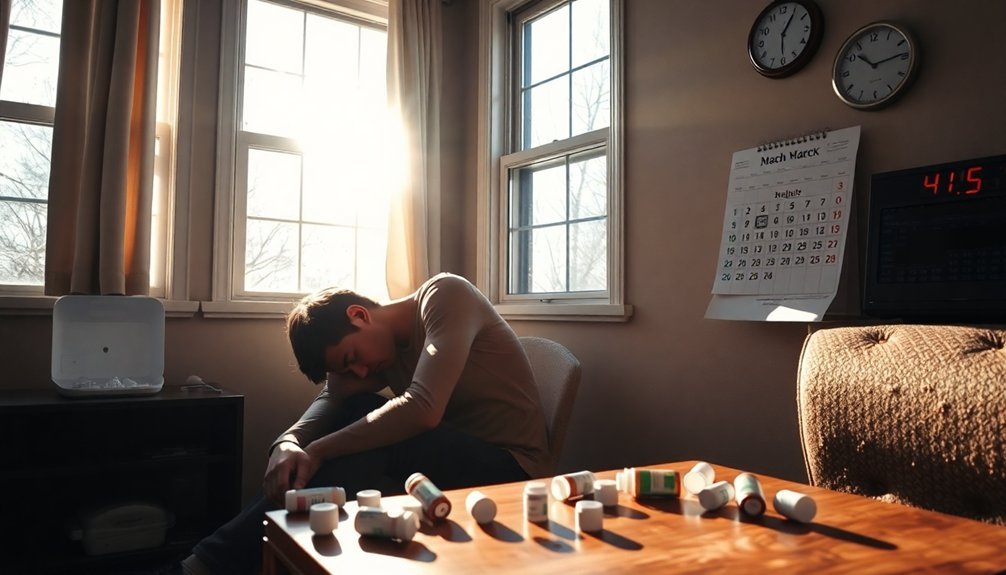
Clear signs of incorrect treatment timing can severely impact the effectiveness of SAD management. You'll notice poor results when you've started treatment after symptoms become severe or haven't aligned your approach with your specific seasonal pattern. Watch for persistent or worsening symptoms despite treatment, as this often indicates your timing is off.
| Warning Sign | What It Means |
|---|---|
| Sudden Symptom Spikes | You've started treatment too late or ended it too early |
| Treatment Resistance | Your timing isn't aligned with your seasonal pattern |
| Frequent Relapses | Treatment duration isn't matching your full seasonal cycle |
| Inconsistent Results | Your monitoring and adjustments aren't frequent enough |
| Early Season Struggles | You haven't initiated preventive measures early enough |
You're likely experiencing timing issues if you're not seeing improvement within the expected timeframe or if your symptoms persist beyond the typical five-month duration. Pay attention to how your symptoms correlate with seasonal shifts, especially during daylight saving time changes. If you're not regularly evaluating and adjusting your treatment plan, you might miss vital windows for intervention, leading to suboptimal results and increased risk of symptom recurrence.
Finding Your Personal Schedule
Your sleep patterns serve as the foundation for creating an effective SAD treatment schedule, so it's essential to understand your natural wake and rest cycles.
You'll want to start with light therapy within the first hour of waking, though you can adjust this timing based on how your body responds over the first two weeks.
If morning sessions don't yield results, you're free to experiment with evening light therapy, as research shows both timing options can be equally effective for many people.
Sleep Patterns Matter Most
Sleep schedules serve as the foundation for managing Seasonal Affective Disorder (SAD) effectively. When you establish consistent sleep-wake patterns, you'll find that your mood becomes more stable and your energy levels improve.
It's particularly vital since SAD often disrupts normal sleep patterns, causing excessive daytime sleepiness and prolonged nighttime sleep that doesn't leave you feeling refreshed.
Your sleep habits directly influence your emotional well-being, and irregular patterns can worsen SAD symptoms. Even if you're tempted to sleep longer during shorter winter days, maintaining your regular schedule is essential.
Pay attention to these key aspects of sleep management:
- Go to bed and wake up at the same times daily, even on weekends, to regulate your circadian rhythms
- Avoid daytime napping, as it typically won't provide relief from SAD-related fatigue and may disrupt nighttime sleep
- Incorporate regular exercise into your routine to support better sleep quality and help regulate your body's natural sleep-wake cycle
Light Therapy Timing Tips
Beyond maintaining consistent sleep patterns, finding the right timing for light therapy can dramatically improve your SAD treatment results. The most effective approach starts with understanding your personal melatonin onset – the time when your body naturally begins producing this sleep hormone.
You'll get the best results by scheduling your light therapy session about 8.5 hours after this point.
If you can't measure your melatonin onset, you can use your sleep schedule as a guide. Calculate the midpoint of your typical sleep cycle to determine your ideal treatment time. If you're a short sleeper, you might benefit from light therapy around your normal wake time. However, if you're a longer sleeper, you may need to wake up earlier for your session.
Start your treatment 2-4 weeks before your SAD symptoms typically begin, using a 10,000 lux light box for 30-45 minutes each morning. Don't schedule sessions in the evening, as this can disrupt your biological clock.
Light Intensity Requirements
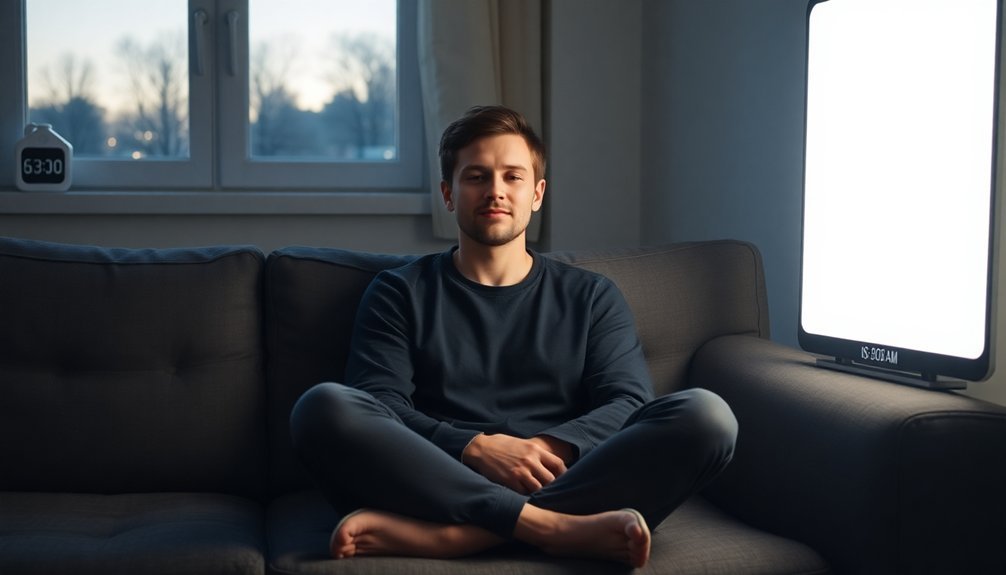
The light intensity required for effective SAD treatment ranges from 2,500 to 10,000 lux, with 10,000 lux emerging as today's industry standard. You'll need a specialized light therapy box, as regular home lighting only emits between 50 to 300 lux – far below the therapeutic threshold.
These boxes use full-spectrum fluorescent light and filter out harmful ultraviolet rays, making them safe for daily use.
Your daily light exposure needs will depend on the intensity level you're using. Consider these key intensity-to-duration ratios:
- 10,000 lux: You'll need 30-minute sessions
- 5,000 lux: Plan for 60-minute sessions
- 2,500 lux: Expect 120-minute sessions
For best results, you'll want a light box that can deliver 10,000 lux at eye level, with the flexibility to adjust intensity if needed. Position your light box on a tabletop or stand that raises it to or above eye level.
Most people see improvements within one to two weeks of consistent use, but you should continue treatment throughout the winter months to maintain benefits and prevent relapse. You might even want to start treatment in early fall to prevent symptoms from developing.
Combining Therapies for Success
Successful SAD treatment often involves combining multiple therapeutic approaches to maximize effectiveness. When you're seeking the best results, combining light therapy with CBT and possibly medication can create a more thorough treatment strategy. Starting these treatments before winter arrives helps prevent symptom onset and maintains better control throughout the season.
| Treatment Combination | Key Benefits |
|---|---|
| Light Therapy + CBT | Better long-term outcomes and reduced symptom recurrence |
| CBT + Medication | Enhanced management of severe symptoms with preventive benefits |
| Light Therapy + Medication | Improved symptom control with complementary effects |
You'll need to work closely with your healthcare provider to develop a personalized treatment plan that may include multiple approaches. They'll help monitor your progress and adjust treatments as needed. If you're considering medication, your provider will carefully evaluate potential interactions and side effects when combining it with other therapies. Remember that maintaining your treatment routine is essential, even after symptoms improve. Regular monitoring and adjustments to your treatment combination guarantee you're getting the most effective care for your specific needs.
Treatment Duration Guidelines
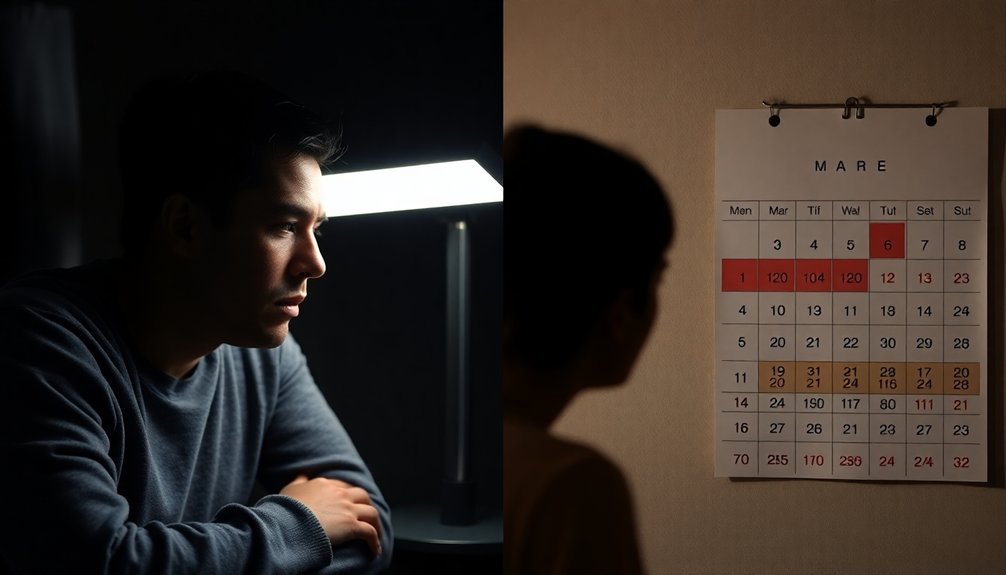
You'll need to commit to daily light therapy sessions of 30 minutes each morning for the best results in treating Seasonal Affective Disorder.
Your treatment should start in early autumn before symptoms appear and continue through the winter season until natural spring remission occurs.
Once you've achieved symptom control, you can work with your healthcare provider to adjust your treatment schedule, possibly reducing sessions to weekdays only while still maintaining therapeutic benefits.
Length of Daily Sessions
Managing SAD requires specific treatment durations for ideal results.
When you're using light therapy, you'll need to dedicate at least 20 minutes each morning to sit in front of your light therapy box. For maximum effectiveness, it's vital to maintain consistency with your daily sessions throughout the winter months, starting in early fall to prevent symptom onset.
If you're pursuing CBT, your sessions will be structured but flexible in length, focusing on developing practical coping strategies.
When medications are part of your treatment plan, you'll need to commit to taking them consistently for several weeks before experiencing full benefits, and it's necessary to continue them beyond your typical symptom period.
Light Therapy Schedule
- 20+ minutes daily
- Morning sessions preferred
- Results typically show within 1-2 weeks
CBT Timeline
- Short-term, goal-oriented sessions
- Flexible duration based on needs
- Can be combined with other treatments
Medication Protocol
- Daily consistent dosing
- Several weeks for full effectiveness
- Gradual discontinuation under supervision
You'll also want to incorporate daily wellness activities, including regular exercise and stress management techniques, to complement your primary treatment methods.
Optimal Treatment Cycles
The best treatment cycle for SAD follows a predictable annual pattern that begins in early fall. You'll want to start your treatment before symptoms appear, typically in early autumn, as this preventative approach helps ward off severe depressive episodes.
It's vital to maintain your treatment consistently through the winter months to achieve optimal benefits.
You should expect a 4-to-6-week period before antidepressants reach their full effectiveness, so timing your treatment initiation is critical. During this time, you'll need to combine medication with other therapeutic approaches, such as light therapy and lifestyle modifications, to maximize your results.
Regular exercise, healthy eating, and stress management techniques like meditation can strengthen your treatment's impact.
When spring approaches and symptoms naturally begin to subside, don't stop your treatment abruptly. You'll need to work with your healthcare provider to gradually discontinue medication to prevent relapse.
Remember that your treatment cycle may need adjustments based on your individual response and symptom patterns. Keep in mind that maintaining continuous communication with your healthcare provider throughout the seasonal shifts will help guarantee your treatment cycle remains effective.
Seasonal Treatment Adjustments
Successful treatment of SAD calls for careful adjustments throughout the year, especially when seasons change. You'll need to adapt your treatment approach proactively rather than waiting for symptoms to appear.
Morning light therapy can effectively phase-advance your circadian rhythm, though some studies suggest flexibility in timing can still yield positive results.
When you're managing SAD, consider these critical seasonal adjustments:
- Start preventive treatments before fall arrives to maintain normal daily rhythms and prevent depressive episodes from taking hold, particularly if you're using antidepressants that require 4-8 weeks to become effective.
- Adjust your light therapy schedule based on your body's response, remembering that morning sessions are typically more beneficial for most patients than evening exposure.
- Incorporate CBT-SAD into your treatment plan during periods of change, as it offers longer-lasting benefits compared to light therapy alone.
You'll want to maintain consistent treatment cycles while making necessary adjustments to prevent symptom recurrence. Your treatment plan might include a combination of light therapy, medication, and psychotherapy, requiring regular fine-tuning as seasons shift and your body's needs change.
Frequently Asked Questions
Can Pregnancy or Breastfeeding Affect SAD Treatment Options?
Yes, if you're pregnant or breastfeeding, you'll need adjusted SAD treatments. Some medications require careful monitoring, but you can safely use options like light therapy and talk therapy under healthcare supervision.
Does SAD Treatment Interfere With Certain Medications or Medical Conditions?
Yes, you'll need to be careful with SAD treatments. They can interact with many medications, especially SSRIs and St. John's Wort. Light therapy isn't suitable if you have retinal diseases or recent eye surgery.
Are There Specific Dietary Changes That Can Help Optimize SAD Treatment?
You'll benefit from adding omega-3 rich fish, vitamin D foods, leafy greens, and dark chocolate to your diet. Include berries and nuts while limiting sugar intake to support your SAD treatment's effectiveness.
How Does International Travel or Shift Work Impact SAD Treatment Scheduling?
Both shift work and international travel disrupt your circadian rhythm, making standard SAD treatment timing challenging. You'll need to adjust your light therapy schedule to match your new sleep-wake cycles for maximum effectiveness.
What Insurance Coverage Options Typically Exist for SAD Treatment and Equipment?
You'll need a formal diagnosis and prescription for coverage. Your insurance may cover SAD light boxes as durable medical equipment, replacement bulbs, and related treatments like psychotherapy and medications, but authorization is always required.
In Summary
You'll find that timing truly is everything when treating Seasonal Affective Disorder. By syncing your light therapy with your body's natural rhythms and consistently following treatment guidelines, you're setting yourself up for success. Remember, it's not just about getting the treatment – it's about getting it right. Stick to your personalized schedule, maintain proper light intensity, and you'll maximize your SAD treatment's effectiveness.

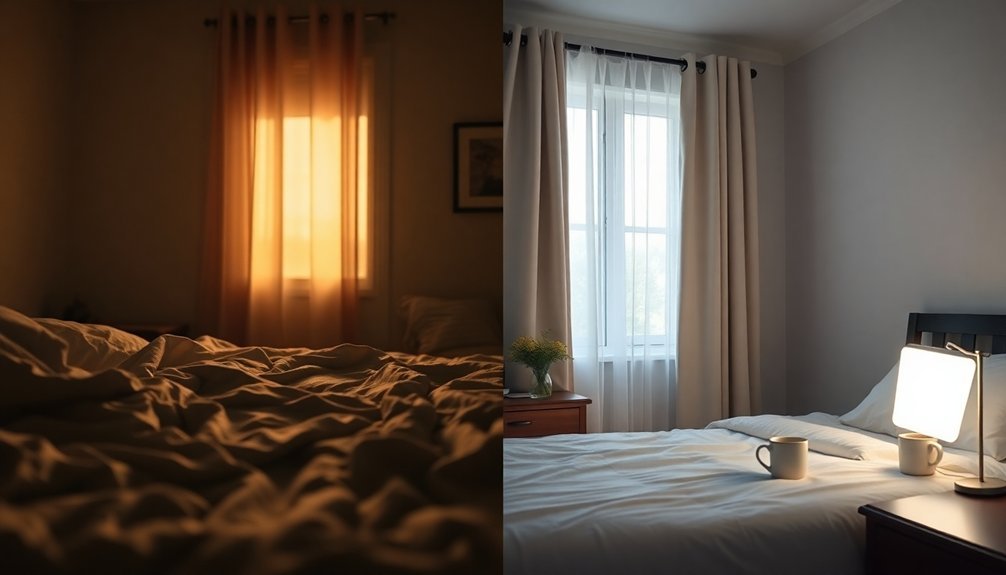



Leave a Reply